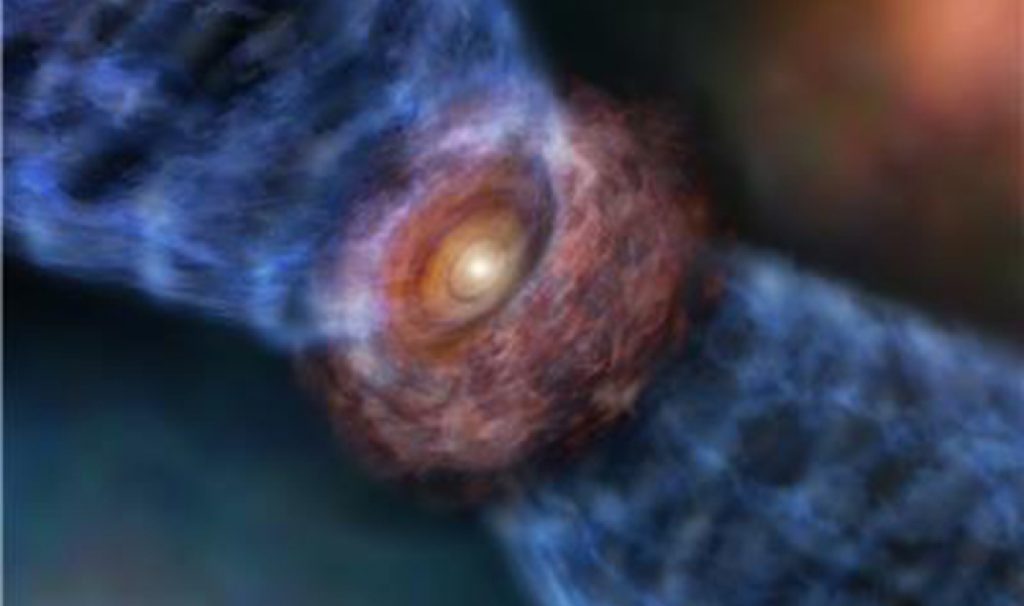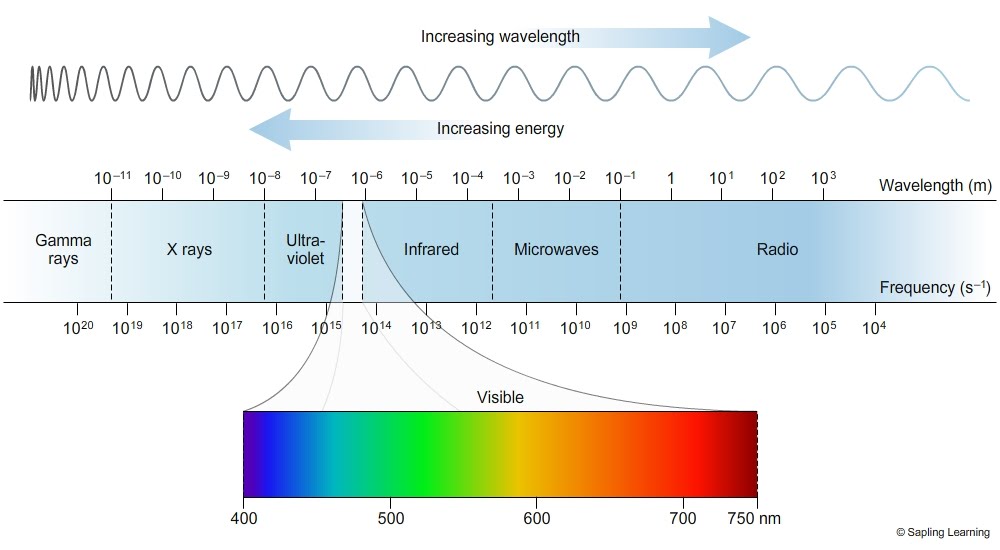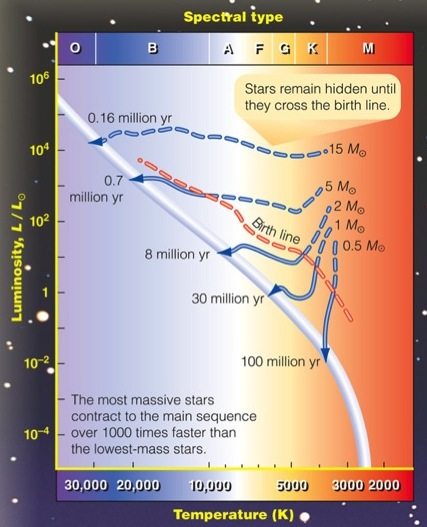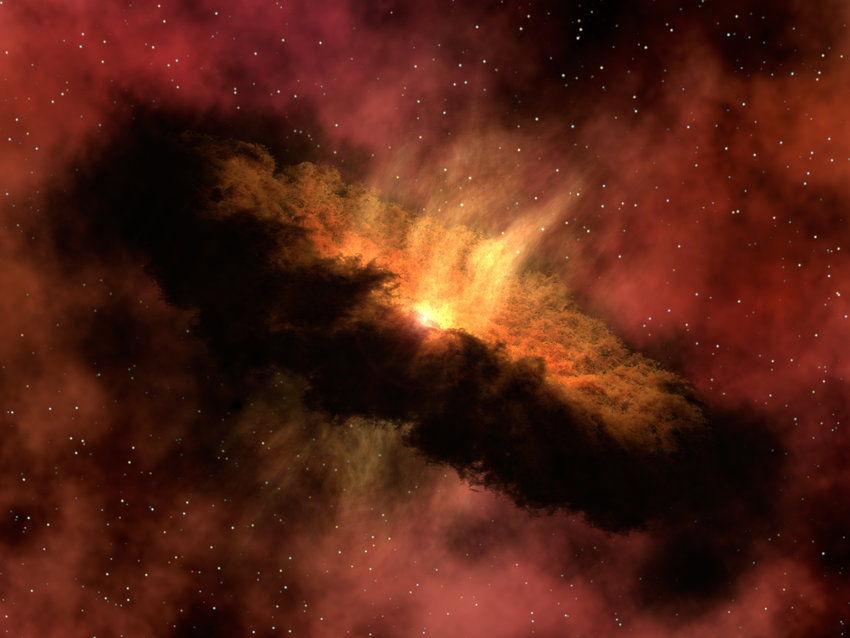
What happens when a star is born?
A couple of posts ago, I explained how a protostar forms out of a dense cloud core within the interstellar medium. But…wait. What exactly is a protostar again?
A protostar forms when one dense core of an interstellar cloud condenses enough so that gravity can overcome the repulsive forces between the particles, and collapse the cloud. A very cool object then forms in the cloud’s depths, visible only at infrared wavelengths—known as a protostar.
A protostar is compressed enough to be opaque no matter the wavelength—that is, no radiation can pass through it due to its density. However, what separates it from a “true” star is that it’s not compressed enough to generate energy by nuclear fusion.
Astronomers also define a protostar specifically as a young star that’s not yet detectable at visible wavelengths. In other words, protostars emit only longer-wavelength light—that is, infrared and radio waves.
You’d think that becoming a true star would be the next step for a protostar. But that’s not quite how it happens…
First, let’s clarify something. What the heck is a “true” star?
Well, astronomers would actually refer to such a star as a “main-sequence” star—or a dwarf star, because they’re much smaller than the most luminous stars in the sky. But…what the heck do I mean by a main sequence?

Remember the H-R diagram?
This graph might look familiar from previous posts. I’ve talked about it a lot. It is, after all, one of the most important concepts in astronomy, second only to the electromagnetic spectrum.
The H-R diagram is a graph of all stars in the universe, relating temperature to luminosity. Luminosity is the total light emitted from a star, not just including visible light—I mean the entire electromagnetic spectrum.
That’s this spectrum, by the way:

So, as you can see above, visible light is only a tiny portion of the electromagnetic spectrum. When we talk about a star’s luminosity, we mean all the energy it puts out, even the wavelengths we can’t see—such as gamma rays and x rays.
Anyway, let’s take a look at the H-R diagram again.

Take a good, long look at this graph. All of those colored circles represent different stars in our sky, graphed according to their temperature and their luminosity.
(By the way, the letter sequence on the temperature axis just means the spectral class. A star’s color corresponds to its temperature, and the different colors are referred to as one of those seven letters.)
The majority of stars fall along the main sequence. This is the longest portion of any star’s life cycle.
No single star will ever traverse the entire main sequence. For example, the sun—a G star of 1 solar luminosity—will never be, say, a B star of 104 solar luminosity (like Bellatrix). As long as it is a main-sequence star, it’ll never be anything other than a G star of 1 solar luminosity.
The main sequence is simply a pattern of temperature relating to luminosity that all stars follow—that is, those still fusing hydrogen in their cores for fuel.
So how does a star get to the main sequence?

Here’s the H-R diagram again—but this time, we’re looking specifically at the main sequence, and the paths stars take to reach it. Each blue arrow represents a different star, each of different masses. The “M⊙” unit means “solar mass”—so 1 M⊙ is a star the mass of the sun, 5 M⊙ is a star with 5 times the mass of the sun, and so on.
You’ll notice a dotted line called the birth line. This represents the stage when a protostar becomes detectable at visible wavelengths—meaning, if it were bright enough (which it’s not), you could see it with your own eyes.
Let’s follow the evolution of one particular newborn star on this diagram: the one that’s 1 M⊙.
This star—which has the same mass as, and very well could be our own sun—begins life as a protostar, newly formed out of a contracting cloud of gas and dust.
Notice its position on the H-R diagram. It’s much cooler—farther to the right on the temperature axis—than it will be when it reaches the main sequence, and it’s also much more luminous. (That is, it’s luminous at infrared wavelengths, which we can’t see.)
The protostar dims as it forms because as it continues to contract from the surrounding dust cloud, its surface area decreases, and there’s a direct relationship between surface area and luminosity.
When the protostar reaches the birth line, we say that it’s been “born.” Because it’s now detectable at visible wavelengths, we don’t call it a protostar anymore. Now it’s a Young Stellar Object (YSO) or a pre-main-sequence star.
But it’s not actually a main-sequence star yet. How long will it take to become one?
Our one-solar-mass star will probably take about 30 million years. Less massive stars will take longer, and more massive stars won’t take as long. A low-mass red dwarf might take as long as a billion years.
When our star ignites hydrogen fusion in its core, it can be said to have reached the main sequence. Our one-solar-mass star will remain a G star of 1 L⊙ (solar luminosity) for the rest of its main-sequence life. It won’t move up or down the main sequence.
When it begins to exhaust its fuel, it’ll move off the main sequence in a way that’s determined by its mass. Our star’s path of changing temperature and luminosity will probably look something like this:

Note that the star isn’t actually moving. Its location on this diagram changes as its temperature and luminosity change, all while it stays in the same location in space.
Now, in this story of a star’s transition from a protostar to a main-sequence star, we’ve neglected one important character: its surrounding dust cloud.
We’ve mentioned that protostars form from a contracting cloud of dust. But not all of that dust becomes part of the protostar. Quite the contrary—it’ll soon become the material for a planetary system.
What happens to this cloud as it contracts?
Well, it’s pretty similar to what happens when a spinning ice skater draws their limbs in close to their body. As they bring all their mass closer to their center of mass, their rotation actually speeds up. That is, they increase their angular momentum.
Conservation of angular momentum is a pretty important concept in physics, but I’ll skip that lesson for the moment. What’s important right now is that as the protostar forms and the cloud contracts, it spins faster.
As the cloud increases its speed, it also flattens—not unlike a blob of pizza dough spun into the air.
Although some of this flattening is due to momentum, some is also due to collisions within the cloud. Particles colliding with one another cancel out their momentum, so that eventually, all the particles are spinning in the same direction around the forming protostar.
Astronomers find that most protostars are surrounded by these flattened clouds, called protostellar disks.

But there’s still one pressing question…how do we know all of this? What evidence confirms this story of star formation?
Those are really good questions. I’ll never begrudge you for wondering how the heck scientists know what they do, because, well, skepticism is one of the most important foundations of science. So I’ll indulge you…in my next post.
P. S.
If you’re following this blog via WordPress, whether through the follow service or by email, I’d really appreciate it if you subscribed to my mailing list instead! Sometime in the next few years, I plan to self-host this website without the WordPress platform, and I’d really love to keep you all as an audience! You can join the mailing list by clicking here.
If you’re worried about getting duplicate content, just unsubscribe from WordPress’s services. Here’s some documentation on how to do that.
Thank you!
Hi Emma, great to see you again and posting stuff. I have a bit to catch up on – I hope you’re good 🙂
LikeLiked by 1 person
I’m great. 🙂 Sometimes school gets in the way of posting, but I try my best to keep to a regular schedule. We finish stellar birth this week and move on to a star’s main-sequence and post-main-sequence evolution, so that’s something to look forward to. Definitely looking forward to writing about it.
LikeLike
I am too, I have a few posts to catch up on as well which I’m sure will be great 😀
LikeLiked by 1 person
Well, I certainly hope so.
I’m a bit bogged down with school at the moment but hope to get a post out for tomorrow…and hopefully I’ll actually manage to get next week’s posts done this week so I’ll be a little ahead.
LikeLike
I just dream of those days… I’m hardly getting anything done.
LikeLiked by 1 person
Well, from a broad standpoint, neither am I. But I’ve narrowed my focus to a few specific items on the agenda so it actually feels like I have time for everything.
LikeLike
Lol .. it’s all a matter of perspective eh?
LikeLiked by 1 person
No kidding. I mean, I have 4 blogs to run, a novel and a fanfic series to write, a guest post to get around to, and work and school. But I’ve set aside 3 of the blogs, I’m ok with barely getting a single post out a week for SaYD (though I’m working up to 4), my creative projects are working on back burner and taking up minimal mental energy, and that guest post is sort of not getting done (need to work on that). I have numerous other fanfic ideas, all of which are getting zero mental energy at the moment. I’ll get to them when I’ve got less on my plate.
LikeLike
You’ve got a lot on your plate I think
LikeLike
shrug Somehow it doesn’t actually feel like a whole lot.
LikeLike
If you’re happy with it…
LikeLiked by 1 person
No complaints at the moment
LikeLike